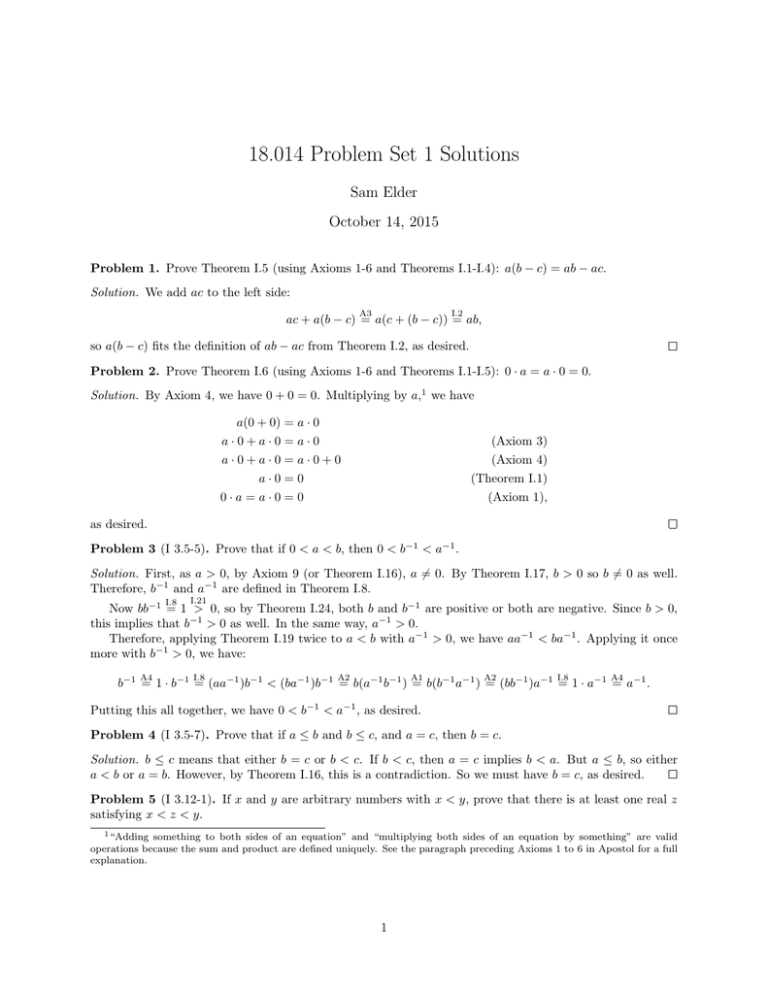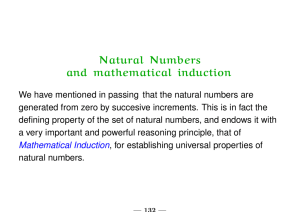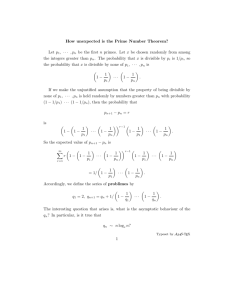18.014 Problem Set 1 Solutions Sam Elder October 14, 2015
advertisement

18.014 Problem Set 1 Solutions Sam Elder October 14, 2015 Problem 1. Prove Theorem I.5 (using Axioms 1-6 and Theorems I.1-I.4): a(b − c) = ab − ac. Solution. We add ac to the left side: A3 I.2 ac + a(b − c) = a(c + (b − c)) = ab, so a(b − c) fits the definition of ab − ac from Theorem I.2, as desired. Problem 2. Prove Theorem I.6 (using Axioms 1-6 and Theorems I.1-I.5): 0 · a = a · 0 = 0. Solution. By Axiom 4, we have 0 + 0 = 0. Multiplying by a,1 we have a(0 + 0) = a · 0 a·0+a·0=a·0 (Axiom 3) a·0+a·0=a·0+0 (Axiom 4) a·0=0 (Theorem I.1) 0·a=a·0=0 (Axiom 1), as desired. Problem 3 (I 3.5-5). Prove that if 0 < a < b, then 0 < b−1 < a−1 . Solution. First, as a > 0, by Axiom 9 (or Theorem I.16), a 6= 0. By Theorem I.17, b > 0 so b 6= 0 as well. Therefore, b−1 and a−1 are defined in Theorem I.8. I.8 I.21 Now bb−1 = 1 > 0, so by Theorem I.24, both b and b−1 are positive or both are negative. Since b > 0, this implies that b−1 > 0 as well. In the same way, a−1 > 0. Therefore, applying Theorem I.19 twice to a < b with a−1 > 0, we have aa−1 < ba−1 . Applying it once more with b−1 > 0, we have: A4 I.8 A2 A1 A2 I.8 A4 b−1 = 1 · b−1 = (aa−1 )b−1 < (ba−1 )b−1 = b(a−1 b−1 ) = b(b−1 a−1 ) = (bb−1 )a−1 = 1 · a−1 = a−1 . Putting this all together, we have 0 < b−1 < a−1 , as desired. Problem 4 (I 3.5-7). Prove that if a ≤ b and b ≤ c, and a = c, then b = c. Solution. b ≤ c means that either b = c or b < c. If b < c, then a = c implies b < a. But a ≤ b, so either a < b or a = b. However, by Theorem I.16, this is a contradiction. So we must have b = c, as desired. Problem 5 (I 3.12-1). If x and y are arbitrary numbers with x < y, prove that there is at least one real z satisfying x < z < y. 1 “Adding something to both sides of an equation” and “multiplying both sides of an equation by something” are valid operations because the sum and product are defined uniquely. See the paragraph preceding Axioms 1 to 6 in Apostol for a full explanation. 1 Solution. Let 2 = 1 + 1 and define z = 2−1 (x + y). (First, 2 = 1 + 1 > 0 by Axiom 7, so 2 6= 0 and 2−1 exists.) We claim that this z satisfies x < z < y. First, I.8 A1 A3 A1,A3 z−x = 2−1 (x+y)−(1+1)2−1 x = 2−1 (x+y)−2−1 (1+1)x = 2−1 ((x+y)−(1+1)x) = 2−1 ((x+y)−(x+x)). Now, y > x implies that x + y = y + x > x + x by Theorem I.18 and Axiom 1. Therefore, since 2−1 > 0 and (x + y) − (x + x) > 0, by Axiom 7, z − x > 0 so x < z. Similarly, I.8 A1 A3 y−z = (1+1)2−1 y−2−1 (x+y) = 2−1 (1+1)y−2−1 (x+y) = 2−1 ((1+1)y−(x+y)) A1,A3,A4 = 2−1 ((y+y)−(x+y)). Again, y > x implies y + y > x + y by Theorem I.18. Since 2−1 > 0 and (y + y) − (x + y) > 0, by Axiom 7, y − z > 0 so y > z as desired. Problem 6 (I 4.4-1b). Prove by induction: 1 + 3 + 5 + · · · + (2n − 1) = n2 . Solution. We induct on n. Base Case. n = 1. Then since 2(1) − 1 = 1, the left side is just 1. The right side is 12 = 1, so they are equal, as desired. Inductive Step. Suppose that the formula is true for n = m, i.e. 1 + 3 + 5 + · · · + (2m − 1) = m2 . Adding 2m + 1 to both sides, we get 1 + 3 + 5 + · · · + (2m − 1) + (2m + 1) = m2 + (2m + 1) = (m + 1)2 , so the formula is true for n = m + 1. Induction is complete. Problem 7 (I 4.4-11). Let n and d denote integers. We say that d is a divisor of n if n = cd for some integer c. An integer n is called prime if n > 1 and if the only poitive divisors of n are 1 and n. Prove, by induction, that every integer n > 1 is either a prime or a product of primes. Solution. First we prove a useful lemma: Lemma. If d is a positive divisor of a positive integer n, then d ≤ n. Proof. By definition, n = cd for some integers c, d. Since n and d are positive, c is also a positive integer. Therefore, c ≥ 1 (see Problem Set 2 for a full proof of this fact) and multiplying both sides by d, we have n = cd ≥ d as desired. Now we induct on n for all n > 1. Base Case. If n = 2, by the lemma, any positive divisors d must satisfy d ≥ 1 and d ≤ 2, and therefore either d = 1 or d = 2, so 2 is prime, as desired. Inductive Step. For n > 2, suppose that all 1 < k < n are either a prime or a product of primes. If n is prime, then we are done. Otherwise, n has some other positive integer divisor d 6= 1, n, so n = cd. By the lemma, 1 ≤ d ≤ n, so 1 < d < n. Then d > 1 implies c < n and d < n implies c > 1, so 1 < c < n as well. By the induction hypothesis, both c and d are primes or products of primes, i.e. products of one or more primes. Since n = cd, n is therefore the the product of primes, as desired. Induction is complete.2 2 This was an application of a technique known as strong induction, where we use more than just the previous case. To fit the format of induction proofs we’ve seen so far, we might instead write a stronger statement: Every integer m with 1 < m ≤ n is either a prime or a product of primes. With this format, in going from the statement for n to the statement for n + 1, we get to use the fact that all integers m satisfying 1 < m < n + 1 are primes or products of primes, as we want. 2 Problem 8 (I 4.7-12). Guess and prove a general rule which simplifies the sum n X k=1 Answer. The sum is 1 . k(k + 1) n . n+1 Solution. We show that n X k=1 n 1 = by induction. k(k + 1) n+1 Base Case. For our base case, we take n = 1. Then the sum just consists of the first term, 1 1 = . 1(1 + 1) 2 1 1 = , so it matches, as desired. 1+1 2 Inductive Step. Suppose that the formula holds for n = m, i.e. Meanwhile, the proposed formula is m X k=1 m 1 = . k(k + 1) m+1 Now we add the next term to both sides: m+1 X k=1 m X 1 1 m 1 1 = + = + k(k + 1) k(k + 1) (m + 1)(m + 2) m + 1 (m + 1)(m + 2) k=1 = m(m + 2) + 1 m2 + 2m + 1 (m + 1)2 m+1 = = = , (m + 1)(m + 2) (m + 1)(m + 2) (m + 1)(m + 2) (m + 1) + 1 as desired. Induction is complete. 3






